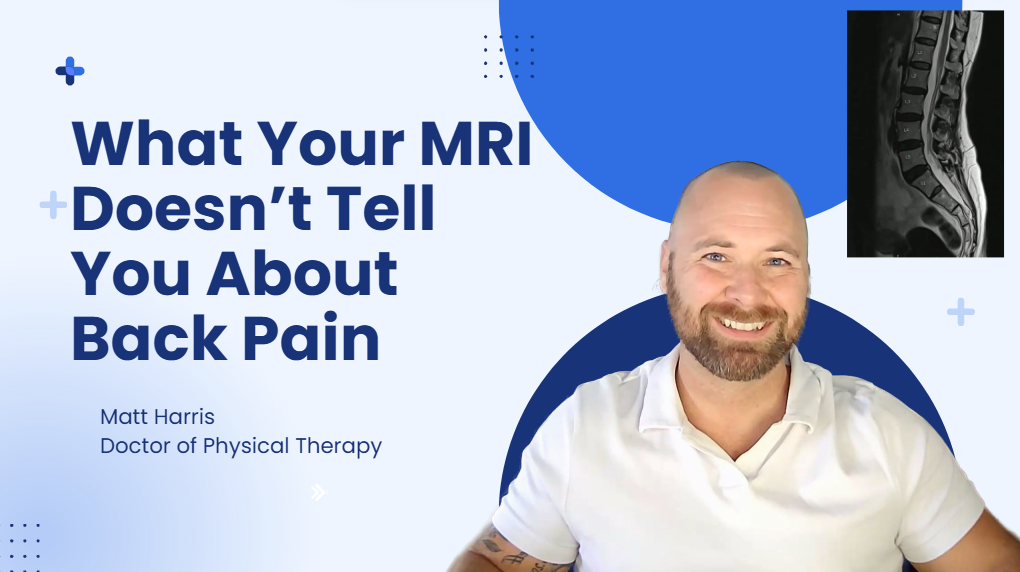
What Your MRI Doesn’t Tell You About Back Pain
🎥 Prefer video? Watch the full breakdown here.
Why Your MRI Isn’t the Whole Story
If you’ve been told your MRI shows a bulging disc or degeneration, it can feel alarming. The word “degeneration” alone sounds like something is falling apart. But here’s what most people don’t realize: these findings are incredibly common, even in people with zero back pain.
In fact, multiple studies have put pain-free people through MRIs and found:
-
More than half had bulging discs
-
Over a quarter had herniated discs
-
Nearly two-thirds showed some “abnormal” finding
And yet, none of them had back pain.
That tells us something important: an MRI image doesn’t always explain your symptoms.
What an MRI Really Shows
Think of an MRI as a snapshot. It captures the structure of your spine, but not how it feels or functions. It can pick up on disc bulges, arthritis, or degeneration, but it can’t tell us whether those changes are actually causing your pain.
This is why we often see people with scary-looking MRIs who feel perfectly fine — and others with “clean” scans who are in significant pain.
It’s kind of like cars: a little rust on the bumper doesn’t mean the engine won’t run smoothly. In the same way, a spine with wear and tear can still move, adapt, and perform well.
Why This Matters for You
Degenerative changes like disc bulges or arthritis don’t automatically mean you’re broken. They don’t mean you’re fragile. What matters far more is how you move, how strong you are, and how you take care of your spine.
Research shows this clearly:
-
Disc bulges and even herniations show up all the time in people with no pain at all.
-
Many herniations shrink or heal on their own over time — no surgery required.
-
Structural changes on an MRI often existed long before your pain began.
So, if your MRI says “degeneration” or “herniation,” don’t panic. It might not be the root cause of what you’re feeling.
Your Body Is Resilient
Here’s another way to look at it: imagine someone wakes up with a sudden flare-up, gets an MRI, and the report shows disc degeneration or facet changes. Those changes didn’t appear overnight. They were likely there long before the pain started.
So the real question is: are those findings actually the cause of the current pain, or are they simply background “noise” that’s unrelated?
The point is simple: your spine is stronger and more adaptable than the MRI report suggests.
Take Action, Not Fear
An MRI can show changes, but it can’t tell your whole story. Your body isn’t broken. It’s built to adapt, bend, and recover — especially when you support it with the right movement and strategies.
If this message is hitting home, I’d like to give you something practical you can start today. I put together a free mini course where I teach four simple, back-saving techniques. They’re easy to apply, and they’ll give you a solid starting point if you’re concerned about making your back worse while trying to stay active.
👉 Grab the free mini course here.
References
-
Jensen MC, et al. Magnetic Resonance Imaging of the Lumbar Spine in People Without Back Pain. N Engl J Med. 1994;331(2):69–73.
-
Boden SD, et al. Abnormal Magnetic-Resonance Scans of the Lumbar Spine in Asymptomatic Subjects: A Prospective Investigation. J Bone Joint Surg Am. 1990;72(3):403–408.
-
Borenstein DG, et al. The Value of Magnetic Resonance Imaging of the Lumbar Spine to Predict Low-Back Pain in Asymptomatic Individuals: A 7-Year Follow-Up Study. J Bone Joint Surg Am. 2001;83-A(9):1306–1311.
-
Weishaupt D, et al. MR Imaging of the Lumbar Spine: Prevalence of Intervertebral Disk Extrusion and Sequestration, Nerve Root Compression, End Plate Abnormalities, and Osteoarthritis of the Facet Joints in Asymptomatic Volunteers. Radiology. 1998;209(3):661–666.
-
Boos N, et al. Diagnostic Accuracy of Magnetic Resonance Imaging, Work Perception, and Psychosocial Factors in Identifying Symptomatic Disc Herniations. Spine. 1995;20(24):2613–2625.
About the Author
Dr. Matt Harris, DPT, MS, is a Doctor of Physical Therapy with 18+ years of experience helping people with spinal conditions. He provides straight-to-the-point back pain solutions — from recovery to lifelong lifting. No fluff. Just spine-safe training you can trust.
Having lived through his own back injuries and guided thousands of patients, Matt knows what it takes to go from pain and setbacks back to safe, confident training.
📩 Start your own recovery journey today: Get the free mini-course here.

